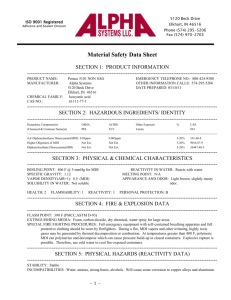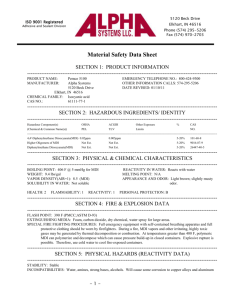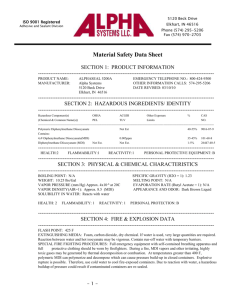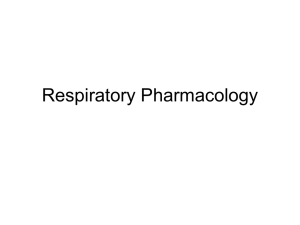1.Background - Lindum Group
advertisement
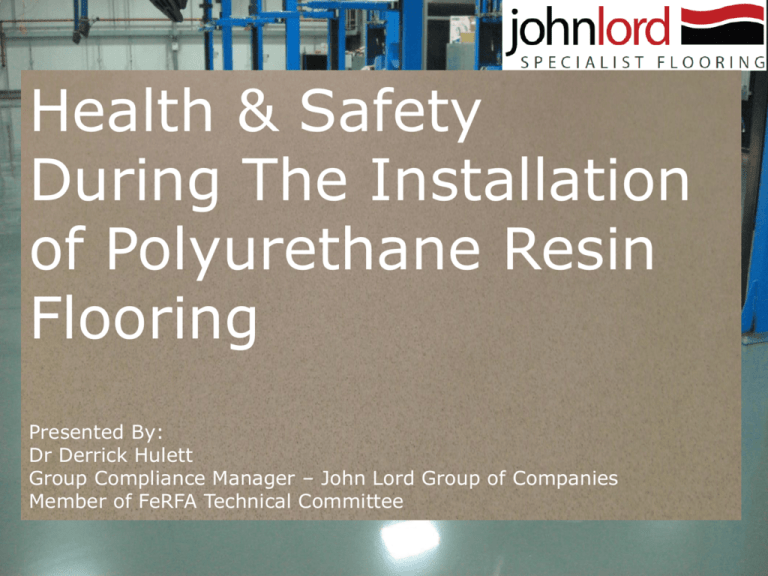
Health & Safety
During The Installation
of Polyurethane Resin
Flooring
Presented By:
Dr Derrick Hulett
Group Compliance Manager – John Lord Group of Companies
Member of FeRFA Technical Committee
CONTENTS
1. Background
2. Recent Developments
3. Control Measures
4. John Lord Approach
5. References
1.Background
•
Current Health & Safety Fears
•
•
•
•
•
Origin of the Health & Safety Issues
•
•
•
•
Is the MDI in polyurethane resin a Carcinogen?
Does the MDI also cause industrial Asthma?
Does the dust in the aggregates cause Silicosis?
Is the only safe way of protecting against these threats is to wear
positive pressure full face respirators
MDI exposure study reported in the Journal of Toxicological Science
(1994)
EU MDI Risk Assessment Report
Reclassification of MDI’s (2005)
HSE’s Involvement
•
•
•
Fit3 Disease Reduction Programme
Dust & Fume Project
REACH
1.Background
•
MDI as a Carcinogen
•
•
•
In 2008 the 30th Adaptation to Technical Progress (ATP) of the
Dangerous Substances Directive classified MDI (CAS No. 26447-40-5)
as R40 – Category 3 carcinogen “Limited evidence of a Carcinogenic
effect.”
In December 2010 the CLP regulations classified MDI as H351:
Suspected of causing cancer by inhalation. Cat 2 Carcinogen
“substances which it is assumed can cause cancer, on the basis of
reliable animal evidence.”
However
•
•
Different CAS Number (9016-87-9)
Animal study not representative of substance used in flooring. (to be
discussed later)
1.Background
•
MDI as a cause of Asthma
•
•
•
There are approximately 17,000 new cases of occupational asthma each
year .
One major cause is the inhalation of MDI mists particularly in the 2 pack
isocyanate paint spraying of vehicles.
However
•
In paint spraying the particle size and the aerosol state enables the
isocyanate to be inhaled. This is not the case with the MDI used in
polyurethane flooring.
1.Background
•
Silicosis from Dust in Aggregates
•
•
•
Workers exposed to fine dust containing quartz are at risk of developing
a chronic and possibly severely disabling lung disease known as
"silicosis".
In addition to silicosis, there is now evidence that heavy and prolonged
workplace exposure to dust containing crystalline silica can lead to an
increased risk of lung cancer. The evidence suggests that an increased
risk of lung cancer is likely to occur only in those workers who have
developed silicosis.
However
•
•
Excessive long term exposures to almost any dust, are likely to lead to
respiratory (breathing) problems.
Preventing inhalation through the use of a simple FFP3 dust mask (face
fit tested) will remove the problem.
1.Background
•
Use of Full Face (Air Fed) Respirators
•
•
•
Respirator manufacturers will advise that the only truly safe form of
respirator against respirable MDI is an air fed mask which does not
contain standard filters.
The reason for this is that although filters such as “Abek” and even FFP3
will filter out the MDI, the breakthrough period cannot be established.
However
•
The MDI used is not respirable.
1.Background
•
MDI Exposure Study
•
•
•
In 1994 an article was produced for the Toxicological society describing
MDI inhalation tests carried out on 60 Wistar rats (Reuzel et al 1994).
One conclusion was that chronic exposure to polymeric MDI at a level of
6.0 mg/m3 was related to the occurrence of pulmonary tumours.
However
•
•
•
•
•
60 rats were tested over a two year period.
The MDI was aerosolised to make it inhalable.
Exposures at other levels (0.2 & 1.0 mg/m3) did not lead to any
tumours.
Only 1 rat at the 6.0 mg/m3 dose developed a pulmonary tumour.
Some of the rats developed other tumours totally unrelated to the
study.
1.Background
•
EU MDI Risk Assessment
•
•
•
•
In 2005 a department of the Belgian government carried out a risk
assessment on behalf of the European Union into MDI (CAS No. 2644740-5) .
Among the conclusions from the assessment it was stated that “There
is a need for limiting the risks” to workers and consumers who come
into contact with this type of MDI.
This assessment undoubtedly influenced the subsequent reclassification
of MDI MDI (CAS No. 26447-40-5) .
However
•
•
The risk assessment used the findings of the study by Reuzel et al.
Once again, different CAS Number (9016-87-9)
1.Background
•
Reclassification of MDI
•
•
As mentioned earlier 30th ATP of the Dangerous Substances Directive
classified MDI (CAS No. 26447-40-5) as R40 – Category 3 carcinogen
“Limited evidence of a Carcinogenic effect” and the CLP regulations
classified MDI as H351: Suspected of causing cancer by inhalation. Cat
2 Carcinogen “substances which it is assumed can cause cancer, on the
basis of reliable animal evidence.”
However
•
•
Different CAS Number (9016-87-9)
As stated by ISOPA “There will be no impact on workplace health and
safety from this change beyond what is good practice today.”
1.Background
•
HSE Involvement – DRP
•
•
•
•
In 2002 the HSE agreed its “chemicals strategy” and programmes of
work were set up to address disease reduction and management in 3
areas: (Cancer, Respiratory disease and Skin disease.
Since 2004/5 the work has continued under the HSE's Disease
Reduction Programme (DRP).
The objective of the Disease Reduction Programme is to deliver
reductions in the incidence of ill health related to chemicals in the
workplace.
The approach is to target industries for inspection based on the
perceived size of the problem.
1.Background
•
HSE Involvement – Dust & Fume Project
•
•
The Respiratory Diseases Unit within the Long Latency Health Risks
Division (LLHRD) are working on a ‘Dust and Fumes Project’, which aims
to reduce the incidents of respiratory disease by raising awareness of
the long term health effects of inhaling dust and fumes in the
workplace.
Using information gathered over a number of years, five ‘high risk’
industries have been identified for targeted campaigns – (stoneworking,
construction, foundries, quarries and welding.)
1.Background
•
HSE Involvement – REACH
•
•
•
•
•
•
On 22nd June 2009 Annex XVII to Regulation (EC) No 1907/2006
(REACH Regulations) was amended by Commission Regulation (EC) No
552/2009.
In the amended Annex XVII, substance No. 56. Methylenediphenyl
diisocyanate (MDI) CAS No 26447-40-5 EC No 247-714-0 was amended as
follows.
1. Shall not be placed on the market after 27 December 2010, as a constituent of
mixtures in concentrations equal to or greater than 0,1 % by weight of MDI for
supply to the general public, unless suppliers shall ensure before the placing on
the market that:
Gloves provided
Warning notices regarding sensitisation, asthma, ventilation and type
1 masks (ABEK)
Comment
•
The above points in bold highlight some of the confusions
1.Background
•
HSE Involvement – REACH
•
•
HSE is the competent authority (CA)for assessing REACH Compliance in
the UK.
HSE have issued the following statement regarding their future work as
the REACH CA:
•
Targeted inspection campaigns
•
This year sees the launch of a series of substance-specific
inspection campaigns. These campaigns will identify dutyholders
on the basis of detailed intelligence on supply chain activity
surrounding the substances subject to inspection. By comparing
this intelligence to records of registration and pre-registration, we
will be able to target and approach those dutyholders that appear
to be in breach of the core requirements in REACH to register
substances ('no data, no market[8]'). In addition, this will present
us with opportunities to assess compliance with other aspects of
REACH.
2.Recent Developments
•
ISOPA Position Paper
•
HSE Laboratories Research Document
HSL/2005/60
•
FeRFA Consultation with HSE
2.Recent Developments
•
ISOPA Position Paper
•
•
•
ISOPA is the European Diisocyanate and Polyol Producers Association.
In May 2011 ISOPA produced a document entitled: Timeline For The Reclassification And Labeling Of MDI As Substance And Mixtures.
Conclusions of the paper include:
•
The concentration required to cause tumours in the lungs of the
test animals was 6 mg/m³, which is more than 100-times the
MAK-value (0.05mg/m³). These aerosols had to be respirable,
what means that the droplets need to have a so-called
aerodynamic diameter of 10 μm.
•
The particle size, even of aerosol droplets, in industry are
massively larger than this (in excess of 40 μm) making them not
respirable.
•
Health surveillance programmes involving around 12,000 workers
in the MDI processing industry did not show any increased risk of
lung cancer.
2.Recent Developments
•
HSE Laboratories Research Document
HSL/2005/60
•
•
•
Tests were carried out on diisocyanates in 2-pack paint systems.
Although not the exact same process as involved in the installation of
polyurethane resin flooring it is representative.
The following conclusions were arrived at:
•
The laboratory tests found no airborne isocyanate during small
scale mixing and brush and roller application.
•
The static samples were carried out close to the operations under
test and so represent a "worst-case" series of results.
•
These results suggest that airborne isocyanate is not a significant
hazard during these operations
•
The biological monitoring results associated with this work found
no evidence of isocyanate exposure suggesting that the personal
protective equipment (PPE) worn during these operations was
adequate to prevent exposure.
2.Recent Developments
•
FeRFA Consultation with HSE
•
•
•
•
•
FeRFA is the Resin Flooring Association and represents manufacturers
and installers of polyurethane resin flooring.
On the 14th June 2011 members of the Technical Committee of FeRFA
met with representatives of HSE including HM Principal Specialist
Inspector, Head of Health Risks, Management Unit.
At the meeting FeRFA presented evidence broadly as outlined in this
presentation and specifically:
Referred to the MDI Exposure study by Reuzel et al (1994) and
commented that the tests had been carried out at 300 times the
Occupational Exposure Level using a specially prepared finely dispersed
respirable aerosol.
It was also stated that:
•
MDI is not aerosolised in flooring applications
•
MDI has very low vapour pressure
2.Recent Developments
•
FeRFA Consultation with HSE
•
•
FeRFA produced evidence to show that:
•
MDI is not aerosolised in flooring applications
•
MDI has very low vapour pressure
•
The reclassification of MDI has no impact on workplace health &
safety beyond what is good practice today.
•
There is no risk of aerosol isocyanate in normal use of the products
as flooring materials
•
The UK Occupational Exposure Limit (OEL TWA) = 0.02mg/m3 in
an 8 hour period, test
•
results show less than 3% of the OEL during an 8 hour working
period.
During the meeting an agreement was reached as to the control
measures required during the installation of polyurethane resin flooring.
3.Control Measures
•
Based on the evidence presented and
following the Consultation with HSE the
following control measures should be
adopted to provide protection against any
health hazards during the installation of
polyurethane resin flooring.
•
•
•
•
•
•
•
•
Method statement and risk assessments
COSHH assessments
MSDS if required
Lung function health surveillance
Segregation
FFP3 disposable respirators for mixing and floor preparation
Respirators not required for MDI
PPE to prevent skin contact with MDI
4. John Lord Approach
•
The following is a list of Control Measures
adopted by John Lord
•
•
•
•
•
•
Every site has a method statement, risk assessments and COSHH
assessments detailing specific control measures.
Lung function health surveillance is carried out on all persons exposed
to MDI and Crystaline Silica (helps early detection of COPD).
Wherever possible ask for persons not essential to the process of
installing the resin flooring to be segregated from the activity (this is
mainly to remove the risk of skin contact with the MDI and to reduce
the possibility of spillages).
FFP3 masks worn when mixing and when creating dust through floor
preparation. Face fit testing carried out.
Overalls, Impermeable gloves, Safety glasses, Safety boots or shoes,
Special provisions regarding hard hats and glasses for floor layers
5. References
Reuzel, P.G.J, J.E.H Arts, L.G. Lomax, M.H.M Kuijpers, C.F. Kuper, C.
Gembardt, V.J. Feron and E. Löser 1994, Chronic Inhalation Toxicity and
Carcinogenicity Study of Respirable Polymeric Methylene Diphenyl
Diisocyanate (Polymeric MDI) Aerosol in Rats, Toxicol. Sci. (1994)
22(2): 195-210
http://toxsci.oxfordjournals.org/content/22/2/195.short
ISOPA, 2011, Timeline For The Re-classification and Labelling of MDI
as Substance and Mixtures, May 2011
http://www.isopa.org/isopa/uploads/Documents/documents/Timeline%20for%20ReC&L%20of%20MDI%20as%20subtance%20and%20Mixtures.pdf
ISOPA, 2011, EU, MDI-containing Consumer Products, May 2011
http://www.isopa.org/isopa/uploads/Documents/documents/Customer%20Information%20MDI
%20Risk%20Management%20%20EU%20Restrictions.pdf
5. References
Coldwell, M. and J. White, 2005, Measured Airborne Isocyanate from
Mixing and Brush and Roller Application of Isocyanate based 2-pack
Paints, Results - February 2005, HSL/2005/60
http://www.hse.gov.uk/research/hsl_pdf/2005/hsl0560.pdf
European Commission – Joint Research Centre, Institute for Health and
Consumer Protection, European Chemicals Bureau (ECB), European Union
Risk Assessment Report - methylenediphenyl diisocyanate (MDI) - CAS
No: 26447-40-5 EINECS No: 247-714-0, Series: 3rd Priority List Volume: 59
http://eur-lex.europa.eu/LexUriServ/LexUriServ.do?uri=OJ:L:2009:164:0007:0031:EN:PDF
Commission Regulation (EC) No 552/2009
Amending Regulation (EC) No 1907/2006 of the European
Parliament and of the Council on the Registration, Evaluation,
Authorisation and Restriction of Chemicals (REACH) as regards
Annex XVII, 22 June 2009
http://eur-lex.europa.eu/LexUriServ/LexUriServ.do?uri=OJ:L:2009:164:0007:0031:EN:PDF
5. References
Commission Directive 2009/2/EC, Amending, for the Purpose of its
Adaptation to Technical Progress, for the 31st Time, Council Directive
67/548/EEC on the Approximation of the Laws, Regulations and
Administrative Provisions Relating to the Classification, Packaging
and Labelling of Dangerous Substances, 15 January 2009
http://eur-lex.europa.eu/LexUriServ/LexUriServ.do?uri=OJ:L:2009:011:0006:0082:EN:PDF
Commission Directive 2008/58/EC, Amending, for the Purpose of its
Adaptation to Technical Progress, for the 30th Time, Council
Directive 67/548/EEC on the Approximation of the Laws, Regulations
and Administrative Provisions Relating to the Classification,
Packaging and Labelling of Dangerous Substances, 21 August 2008
http://eur-lex.europa.eu/LexUriServ/LexUriServ.do?uri=OJ:L:2008:246:0001:0191:EN:PDF
FeRFA 2011, Reclassification of MDI, 16 June 2011
http://www.ferfa.org.uk/html/pdf/ReclassificationMDInote.pdf

